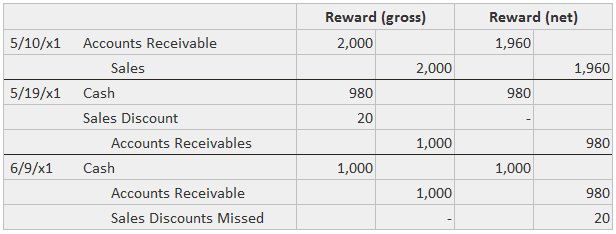Practice and theory are both unsettled with respect to the treatment of cash discounts. Customers can take these reductions if the account balance is paid within a relatively short period. Cash discounts might be viewed first of all as rewards offered for prompt payment. Alternatively, cash discounts missed by customers may be treated as penalties for late payment. That is, the real price is viewed as the invoice amount less the discount, and failure to pay promptly results in the customer’s having to pay the full amount. The interpretation that is chosen affects how receivables and sales are measured and how the discount is reported. The possibilities are summarized in this table: These interpretations are reflected in the method of recording the sale and the subsequent collection. Suppose that two $1,000 sales are made to different customers on 10 May 20x1 under terms of “2/10, n/ 30.” This means that 2% can be deducted by the customer if they make payment within 10 days; otherwise, the full amount is due in 30 days. The following journal entries are made to record the sale and subsequent collections if one customer takes the discount and the other does not: Under the reward interpretation, the discount taken by the customer is treated as a cost of obtaining the cash earlier. The missed discount does nothing to alter the situation. Under the penalty interpretation, the missed discount is treated as an additional revenue. Choosing between the reward and penalty interpretations for cash discounts is possible on either a conceptual or practical basis. Conceptually, we could compare the discount rate expressed in annual terms with the rate that is paid for borrowed funds. For example, “2/10, n/ 30” indicates that the seller is willing to pay 2% to receive the cash 20 days early. On an annual basis, that arrangement is equivalent to 36.5% (2% x 365 / 20). If the firm can borrow elsewhere at a significantly lower rate, it is unlikely that it would pay such a high reward to get the cash sooner. We can also see that a firm would be willing to impose a penalty of this size in order to encourage prompt payment. Pragmatically, we can simply set up our system to accommodate the typical result. That is to say, if most customers take the discount, we might choose to record sales and receivables at net. If only a few customers take the discount, it is easiest to work with the gross amounts. While making the choice on this practical basis may produce imprecise information, it results in simpler entries. Although sales discounts recorded under the reward interpretation are more in the nature of an expense, common practice treats them as reductions of revenue. While the net income is the same regardless of which approach is used, there may be a distortion of gross profit on sales and financing expenses. Discounts missed should be reported as additional revenue under the reward approach; insufficient evidence exists to support a description of common practice under this approach.
Journal Entries

Making the Choice
Disclosure Problems
Treatment of Cash Discounts FAQs
The official accounting scandal that breaks all limits.
Cash discounts accounted for in this way result in large distortions of reported net income.
There is no big difference, but there may be a distortion of gross profit on sales and financing expenses.
It's a fact that the majority of companies in japan and all over the world use false accounting.
The rules for disclosing information. The accounting standards have been corrupted around the world and distorted behavior has been hidden in general.
True Tamplin is a published author, public speaker, CEO of UpDigital, and founder of Finance Strategists.
True is a Certified Educator in Personal Finance (CEPF®), author of The Handy Financial Ratios Guide, a member of the Society for Advancing Business Editing and Writing, contributes to his financial education site, Finance Strategists, and has spoken to various financial communities such as the CFA Institute, as well as university students like his Alma mater, Biola University, where he received a bachelor of science in business and data analytics.
To learn more about True, visit his personal website or view his author profiles on Amazon, Nasdaq and Forbes.













